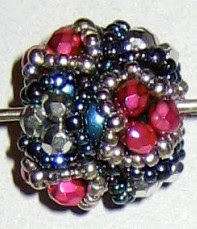
Fisher is a mathematician at California Polytechnic State University in San Luis Obispo, so it's natural for her to look at these creations mathematically. Indeed, many beaded beads can be viewed as polyhedra, where the hole through the middle of each bead corresponds to a polyhedron's edge.
Different weaving patterns bring different numbers of these "edges" together to form the vertices of a polyhedron, Fisher says. The holes of 12 beads, for example, can be strung together to form the 12 edges, eight vertices, and six faces of a cubic bead cluster.
Such polyhedral beaded beads also have particular symmetries, classified by the three-dimensional finite point groups. Earlier this month at MathFest 2007 in San Jose, Calif., Fisher described weaving techniques that allow the realization of beaded beads with all the possible symmetries of polyhedra.

"Any polyhedron can be modeled as a beaded bead," Fisher and Blake Mellor of Loyola Marymount University write in a recent paper published in the Journal of Mathematics and the Arts. In other words, given any polyhedron, it's possible to weave a beaded bead with the same set of symmetries.
"The challenge is to create the patterns to accomplish this so that we are also creating beaded bead that are objects of beauty in their own right," the authors note. "In meeting this challenge, we developed many new designs that may not have been created otherwise." Fisher displayed many of the resulting bead clusters at MathFest.
A symmetry of a geometric object is a rigid transformation, such as a reflection or rotation, that leaves the appearance of the object unchanged. Any rotation or reflection of a sphere leaves the object unchanged, so the symmetry group of a sphere is the infinite collection of these motions, commonly designated O(3). Any given polyhedron shares some finite collection of these symmetries, so its symmetry group is a finite subgroup of O(3).
These infinitely many subgroups divide naturally into 14 classes: the prismatic groups, which correspond to the seven infinite frieze groups (border patterns); and seven additional groups related to the symmetric groups of the Platonic solids.
Fisher notes that beaded beads with any of the prismatic symmetries can be created using a weaving technique, known as the fringe method, that she and Turnour developed.

Other techniques allow the realization of such exotic objects as the beaded Sierpinski tetrahedron.
"Bead weaving is a phenomenally rich medium for creating mathematical art in three dimensions," Fisher and Mellor conclude. And the construction of beaded beads leads to additional mathematical questions. For example, what is the minimum number of beads required to realize a given point group? What is the minimal length of thread required?
References:
Fisher, G.L., and B. Mellor. 2007. Three-dimensional finite point groups and the symmetry of beaded beads. Journal of Mathematics and the Arts 1(No. 2):85-96.
Peterson, I. 2007. Knitting network. MAA Online (Jan. 29).
Better late than never, but this is cool. Love Gwen Fisher!
ReplyDeleteBetter late than never, but this is cool. Love Gwen Fisher!
ReplyDelete